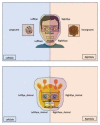Machine learning for distinguishing saudi children with and without autism via eye-tracking data
- PMID: 37777792
- PMCID: PMC10544143
- DOI: 10.1186/s13034-023-00662-3
Machine learning for distinguishing saudi children with and without autism via eye-tracking data
Abstract
Background: Despite the prevalence of Autism Spectrum Disorder (ASD) globally, there's a knowledge gap pertaining to autism in Arabic nations. Recognizing the need for validated biomarkers for ASD, our study leverages eye-tracking technology to understand gaze patterns associated with ASD, focusing on joint attention (JA) and atypical gaze patterns during face perception. While previous studies typically evaluate a single eye-tracking metric, our research combines multiple metrics to capture the multidimensional nature of autism, focusing on dwell times on eyes, left facial side, and joint attention.
Methods: We recorded data from 104 participants (41 neurotypical, mean age: 8.21 ± 4.12 years; 63 with ASD, mean age 8 ± 3.89 years). The data collection consisted of a series of visual stimuli of cartoon faces of humans and animals, presented to the participants in a controlled environment. During each stimulus, the eye movements of the participants were recorded and analyzed, extracting metrics such as time to first fixation and dwell time. We then used these data to train a number of machine learning classification algorithms, to determine if these biomarkers can be used to diagnose ASD.
Results: We found no significant difference in eye-dwell time between autistic and control groups on human or animal eyes. However, autistic individuals focused less on the left side of both human and animal faces, indicating reduced left visual field (LVF) bias. They also showed slower response times and shorter dwell times on congruent objects during joint attention (JA) tasks, indicating diminished reflexive joint attention. No significant difference was found in time spent on incongruent objects during JA tasks. These results suggest potential eye-tracking biomarkers for autism. The best-performing algorithm was the random forest one, which achieved accuracy = 0.76 ± 0.08, precision = 0.78 ± 0.13, recall = 0.84 ± 0.07, and F1 = 0.80 ± 0.09.
Conclusions: Although the autism group displayed notable differences in reflexive joint attention and left visual field bias, the dwell time on eyes was not significantly different. Nevertheless, the machine algorithm model trained on these data proved effective at diagnosing ASD, showing the potential of these biomarkers. Our study shows promising results and opens up potential for further exploration in this under-researched geographical context.
Keywords: Autism spectrum disorder; Eye-tracking; Face Processing; Prediction; Screening.
© 2023. BioMed Central Ltd., part of Springer Nature.
Conflict of interest statement
The authors declare that they have no competing interests.
Figures
Similar articles
-
Classification of Children With Autism and Typical Development Using Eye-Tracking Data From Face-to-Face Conversations: Machine Learning Model Development and Performance Evaluation.J Med Internet Res. 2021 Aug 26;23(8):e29328. doi: 10.2196/29328. J Med Internet Res. 2021. PMID: 34435957 Free PMC article.
-
[Slowing down the flow of facial information enhances facial scanning in children with autism spectrum disorders: A pilot eye tracking study].Encephale. 2017 Feb;43(1):32-40. doi: 10.1016/j.encep.2016.02.005. Epub 2016 Mar 16. Encephale. 2017. PMID: 26995150 French.
-
Atypical gaze patterns to facial feature areas in autism spectrum disorders reveal age and culture effects: A meta-analysis of eye-tracking studies.Autism Res. 2021 Dec;14(12):2625-2639. doi: 10.1002/aur.2607. Epub 2021 Sep 20. Autism Res. 2021. PMID: 34542246
-
Visual social attention in autism spectrum disorder: insights from eye tracking studies.Neurosci Biobehav Rev. 2014 May;42:279-97. doi: 10.1016/j.neubiorev.2014.03.013. Epub 2014 Mar 30. Neurosci Biobehav Rev. 2014. PMID: 24694721 Review.
-
Language development, reading and word learning in Autism Spectrum Disorder (ASD): a review on eye tracking studies.Int J Dev Disabil. 2022 Feb 27;70(1):2-19. doi: 10.1080/20473869.2021.2024404. eCollection 2024. Int J Dev Disabil. 2022. PMID: 38456140 Free PMC article. Review.
References
-
- Deng X, Liu Q, Deng Y, Mahadevan S. An improved method to construct basic probability assignment based on the confusion matrix for classification problem. Inf Sci. 2016;340:250–61. doi: 10.1016/j.ins.2016.01.033. - DOI
LinkOut - more resources
Full Text Sources
Miscellaneous





